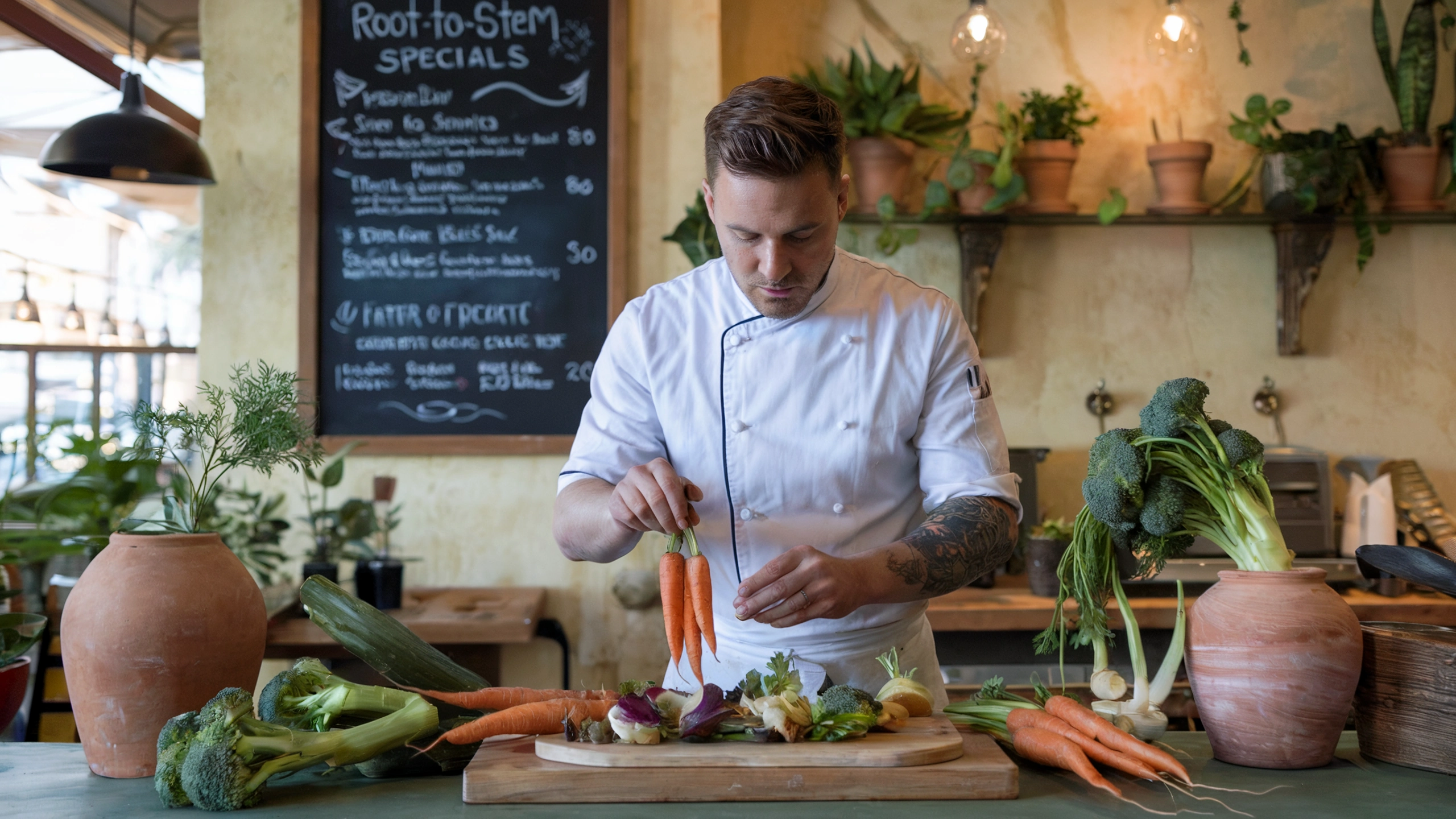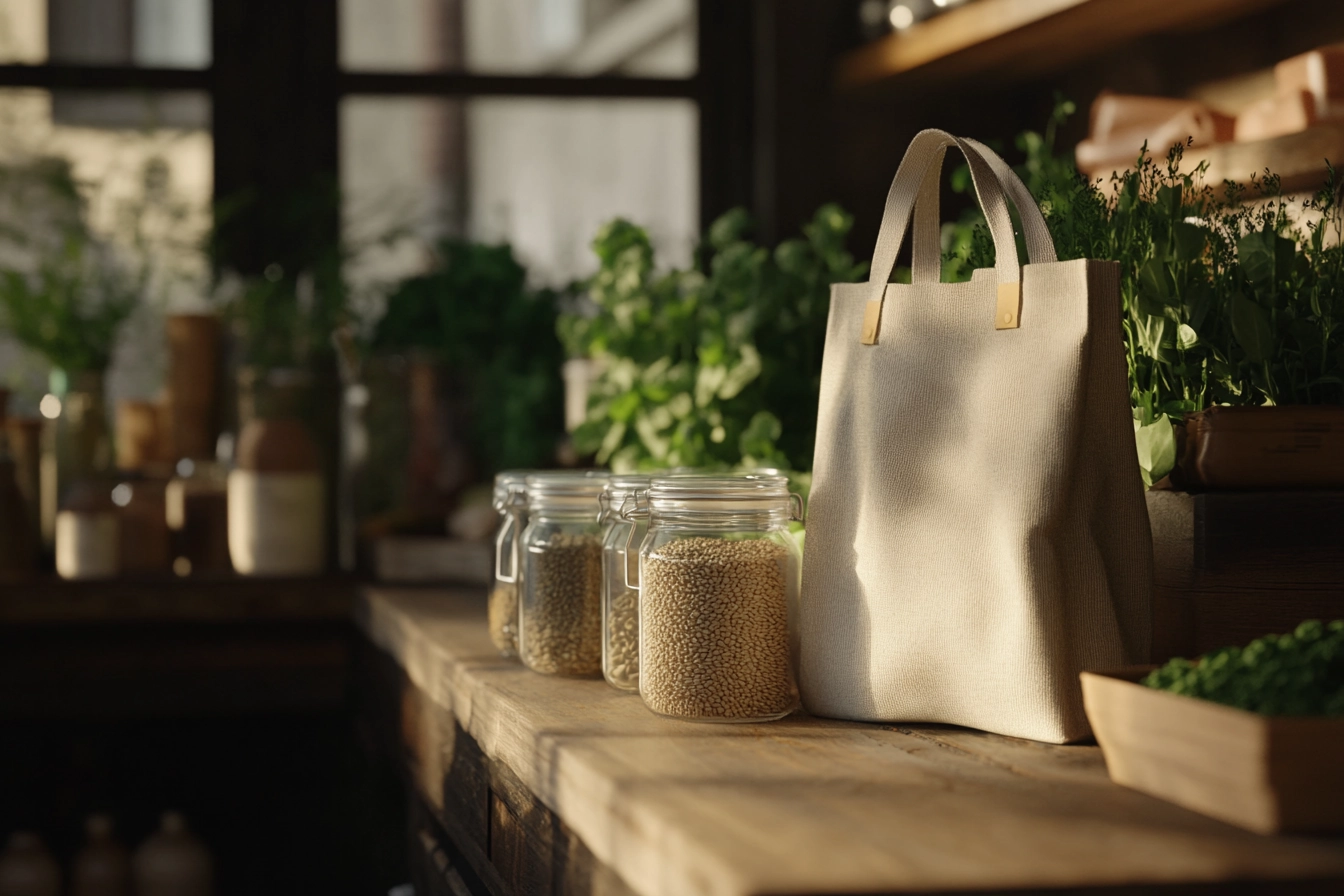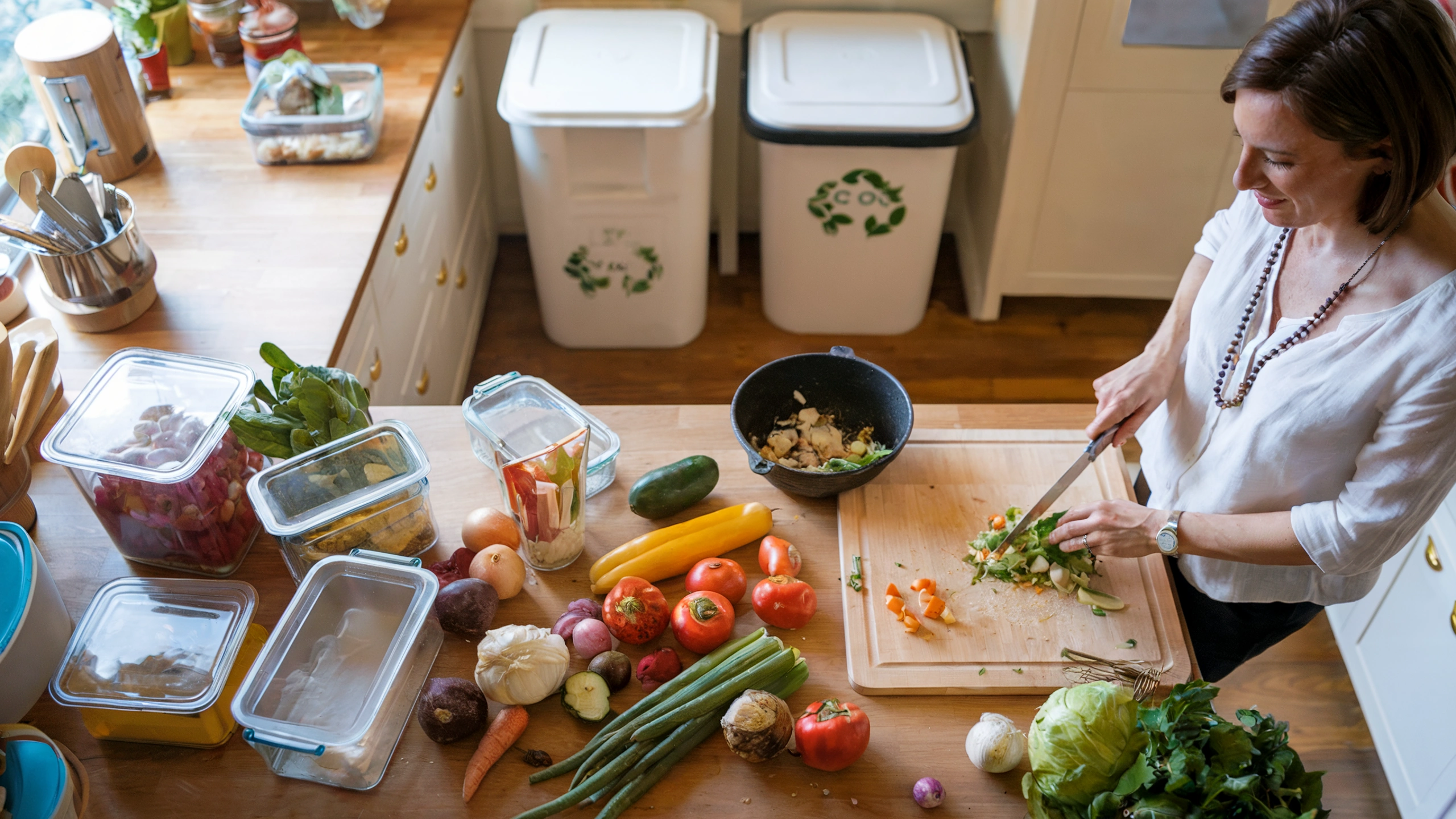Food waste is one of the biggest environmental challenges we face today. From discarded produce at grocery stores to leftovers tossed in household trash bins, an astonishing amount of food ends up in landfills each year. But what if there was a way to rethink the way we cook, shop, and eat? That’s where the zero waste food trend comes in.
At its core, the zero waste food trend focuses on minimizing waste by using every part of an ingredient, composting scraps, and making conscious consumption choices. It’s not just a movement for eco-conscious foodies—it’s transforming restaurants, grocery stores, and home kitchens worldwide.
In This Article
Introduction to the Zero Waste Food Trend
What is the Zero Waste Food Trend?
The zero waste food trend is a sustainability movement aimed at reducing food waste to the bare minimum. It promotes using every edible part of an ingredient, from root to stem in vegetables and nose to tail in meats, to ensure nothing goes to waste. The goal? To create a more sustainable and responsible food system that benefits both people and the planet.
This movement has gained traction in recent years as people become more aware of the impact of food waste. Restaurants, grocery stores, and households are all adopting methods to reduce their waste footprint by repurposing leftovers, composting scraps, and shopping smarter.
Why is Zero Waste Cooking Important?
Did you know that nearly one-third of all food produced globally is wasted? That’s 1.3 billion tons of food per year—a staggering amount that contributes to climate change, deforestation, and resource depletion. The consequences of food waste are far-reaching:
- Environmental Impact: Decomposing food in landfills releases methane, a greenhouse gas even more potent than carbon dioxide.
- Economic Loss: Households waste hundreds of dollars yearly on food they never eat.
- Ethical Concerns: With millions suffering from food insecurity, reducing waste can help redistribute surplus food to those in need.
By adopting zero waste cooking, we can significantly cut down on food waste while saving money and protecting the planet.
How It Differs from Other Sustainability Trends
While zero waste cooking is often associated with other eco-friendly movements, it stands apart in key ways:
- Farm-to-table dining focuses on sourcing ingredients locally, while zero waste cooking ensures those ingredients are fully utilized.
- Veganism and plant-based diets reduce the carbon footprint of animal agriculture, but zero waste applies to all types of food, including meats and dairy.
- Minimalist cooking emphasizes simplicity, but zero waste emphasizes efficiency—finding creative ways to use scraps, leftovers, and overlooked ingredients.
The zero waste food trend is a holistic approach to food sustainability, challenging us to rethink how we consume, cook, and dispose of food.
The Origins and Growth of the Zero Waste Food Trend
When Did Zero Waste Become Popular?
The concept of zero waste has existed for decades, but it wasn’t until the early 2000s that it became a global movement. Environmental advocates and sustainability pioneers pushed for waste reduction in various industries, including food.
In 2012, Bea Johnson’s book Zero Waste Home popularized the zero waste lifestyle, inspiring millions to cut down on waste. Around the same time, restaurants and chefs began adopting zero waste cooking principles to combat food waste and promote sustainability.
Governments and organizations also played a role. In 2015, the United Nations set a goal to cut food waste in half by 2030. Since then, the zero waste food trend has gained momentum worldwide.
The Role of Social Media in the Zero Waste Movement
Social media has been a game-changer in spreading awareness. Platforms like Instagram, YouTube, and TikTok showcase zero waste recipes, meal prep tips, and composting hacks, inspiring people to embrace sustainable food practices. Influencers, chefs, and environmental activists continuously share innovative ways to repurpose food scraps and shop more consciously.
With the rise of viral trends like scrap cooking and DIY plant-based milks, more people are joining the movement. If you’re curious about simple and effective ways to reduce food waste, check out this guide on Zero-Waste Recipes & Sustainable Cooking.
Legislation and Government Initiatives Supporting Zero Waste
Many countries are implementing policies to tackle food waste:
- France was the first country to ban supermarkets from throwing away edible food, requiring them to donate it instead.
- South Korea introduced a mandatory food waste recycling program, reducing landfill waste significantly.
- The United States launched the U.S. Food Loss and Waste 2030 Reduction Goal, aiming to cut food waste in half.
As governments continue to push for food sustainability, more businesses and households are adapting to a zero waste mindset.
Key Principles of Zero Waste Cooking

Root-to-Stem and Nose-to-Tail Cooking
One of the key principles of zero waste cooking is using the entire ingredient—whether it’s a vegetable or a cut of meat. This approach, known as root-to-stem (for plants) and nose-to-tail (for meats), helps minimize food waste while maximizing nutrition and flavor.
- Root-to-stem cooking: Instead of tossing carrot tops or broccoli stems, use them in soups, pestos, or stir-fries.
- Nose-to-tail cooking: Instead of discarding animal bones and fat, use them for broths, stocks, and rendering cooking fats.
Curious about creative ways to use food scraps? Check out this recipe for Carrot Top Chimichurri.
Reducing Packaged Foods and Processed Ingredients
Packaged foods contribute significantly to plastic waste. Adopting a zero waste food lifestyle means buying in bulk, choosing fresh ingredients, and avoiding single-use packaging whenever possible.
- Bring reusable containers to bulk stores for grains, nuts, and spices.
- Opt for fresh produce instead of pre-cut, plastic-wrapped fruits and vegetables.
- Choose glass or compostable packaging when available.
These small choices add up, making a significant difference in reducing food-related waste.
Portion Control and Smart Meal Planning
One of the easiest ways to reduce waste is planning meals ahead of time. Overbuying leads to spoiled food, while poor portioning causes leftovers to go uneaten. Try these strategies:
- Create a weekly meal plan to buy only what you need.
- Use FIFO (First In, First Out): Store older ingredients at the front of the fridge to use them before they spoil.
- Batch cook and freeze leftovers for future meals.
For more guidance on planning zero-waste meals, visit What Are Zero-Waste Meals?
Upcycling and Creative Recipe Development
Food scraps don’t have to go in the trash. Many discarded parts of ingredients can be repurposed into delicious dishes:
- Citrus peels → Homemade zest or infused vinegar
- Potato skins → Crispy baked chips
- Vegetable scraps → Flavorful broth or soup base
Instead of seeing scraps as waste, consider them as opportunities for creativity in the kitchen.
The zero waste food trend isn’t just about reducing waste—it’s about rethinking the way we use food. With these principles, you can take simple yet impactful steps toward a more sustainable lifestyle.
The Role of Restaurants and the Food Industry
How Restaurants Are Adopting the Zero Waste Model
Restaurants are at the forefront of the zero waste food trend. Many chefs and food establishments are actively redesigning their menus and operations to reduce waste. By using food scraps creatively, composting leftovers, and sourcing locally, these businesses help lower their environmental impact.
Some well-known restaurants, like Nolla in Finland and Silo in the UK, operate on zero-waste principles, ensuring that nothing goes to waste. They compost scraps, partner with food suppliers who use minimal packaging, and serve meals that use every part of an ingredient.
Fast-food chains are also catching on. Companies like Chipotle and Starbucks have started food waste reduction initiatives, proving that sustainable practices can work at any scale.
For those looking to cook at home, restaurants often serve as inspiration. If you want to try cooking with minimal waste, check out these zero-waste recipes and sustainable cooking tips.
Chefs Leading the Movement
Top chefs worldwide are advocating for zero waste cooking. Notable figures like Massimo Bottura, founder of Food for Soul, and Dan Barber, creator of waste-based fine dining, are showing that food scraps can turn into gourmet meals.
These chefs champion root-to-stem and nose-to-tail cooking, proving that everything from vegetable peels to animal bones can be used in delicious ways. Their influence has helped change how people view “food waste,” encouraging others to be more resourceful in the kitchen.
Technology and Innovation in Food Sustainability
Technology is playing a big role in helping businesses reduce waste. Some key innovations include:
- Food waste tracking apps that help restaurants measure and minimize waste.
- AI-powered inventory management to prevent over-ordering.
- Composting and anaerobic digestion systems that convert food scraps into energy.
Supermarkets are also implementing dynamic pricing, where items nearing expiration are sold at lower prices to encourage immediate consumption. These advancements are reshaping the industry, making zero waste food practices more accessible.
How to Practice Zero Waste Cooking at Home

Tips for Shopping and Storing Food Efficiently
Practicing zero waste cooking at home starts with smart shopping and storage habits. Here are some simple ways to reduce waste:
- Plan your meals: Creating a weekly meal plan prevents impulse purchases and overbuying.
- Buy in bulk: Purchasing grains, nuts, and spices from bulk bins reduces packaging waste.
- Store food properly: Keep herbs fresh by placing them in a glass of water, and store grains in airtight containers to prevent spoilage.
- Use a “first in, first out” system: Always consume older ingredients before opening new ones.
Composting and Recycling Leftovers
Even with the best efforts, some food waste is inevitable. Instead of throwing scraps away, consider composting. Composting turns food waste into nutrient-rich soil, which can be used for gardening.
If composting isn’t an option, food-sharing apps allow people to donate unused food to those in need. You can also repurpose leftovers into new meals. For example:
- Leftover rice → Fried rice or rice pudding.
- Vegetable peels → Homemade veggie broth.
- Overripe bananas → Smoothies or banana bread.
For more guidance, check out What Are Zero-Waste Meals?.
DIY and Homemade Alternatives to Packaged Foods
One of the best ways to reduce food waste is to make homemade versions of packaged foods. This cuts down on plastic waste while allowing you to control ingredients. Some easy swaps include:
- Homemade broth instead of store-bought.
- DIY nut milk instead of packaged versions.
- Freshly baked bread instead of plastic-wrapped loaves.
Making these items at home not only reduces waste but also enhances flavor and nutrition.
Sustainable Cooking Methods
How you cook matters too! Using energy-efficient cooking methods can help cut waste and reduce your carbon footprint:
- Use a pressure cooker: Reduces cooking time and energy use.
- Cook with residual heat: Turn off the oven a few minutes early and let the remaining heat finish the job.
- Batch cook meals: Saves time, energy, and prevents waste.
By following these simple habits, you can make your kitchen more sustainable. If you’re curious about sustainable lifestyle tips beyond cooking, check out What Are the 5 Rules of Zero Waste?.
The zero waste food trend isn't just about saving food—it's about rethinking the way we consume, cook, and discard ingredients. With the right approach, anyone can reduce waste, save money, and make a positive impact on the environment.
Challenges and Criticisms of the Zero Waste Food Trend
Is Zero Waste Realistic for Everyone?
While the zero waste food trend has gained traction, it isn’t always practical for everyone. Many people struggle with time, access, and affordability, making it difficult to follow a zero-waste lifestyle consistently.
For example, urban dwellers may not have space for composting, while low-income families might find bulk, organic, or package-free foods more expensive than conventional options. Additionally, cooking every part of an ingredient requires extra effort, which not everyone has the time for.
Despite these challenges, even small changes—like meal planning and using leftovers creatively—can make a difference. The key is to do what’s possible within your means rather than striving for perfection.
The Cost Factor: Is It More Expensive?
One of the biggest misconceptions is that zero waste cooking is costly. While some sustainable options, like organic produce and bulk goods, may have higher upfront costs, they often save money in the long run by reducing food waste.
Buying only what you need, repurposing leftovers, and using every part of an ingredient can cut grocery expenses significantly. Simple habits, like making homemade broths or using vegetable scraps in stir-fries, can make zero-waste living both affordable and efficient.
Greenwashing and Misuse of the Zero Waste Label
Not all brands claiming to be “zero waste” actually practice sustainability. Many companies use greenwashing—marketing tactics that make products appear more eco-friendly than they are. Some restaurants and food brands promote zero waste initiatives while still generating large amounts of waste behind the scenes.
Consumers should be mindful of these tactics, researching companies that genuinely prioritize sustainability over profit-driven claims.
The Future of Zero Waste in the Food Industry

Emerging Trends in Sustainable Dining
The zero waste food trend continues to evolve, shaping the future of dining and food production. Some emerging trends include:
- Lab-grown meat and plant-based innovations to reduce food waste from animal products.
- Edible packaging, such as seaweed-based wraps, to eliminate plastic waste.
- Food-sharing apps, allowing people to donate excess food before it goes bad.
These innovations could redefine how we approach sustainability, making zero-waste cooking more mainstream.
How the Zero Waste Movement is Evolving
As awareness grows, governments, businesses, and individuals are taking bigger steps toward waste reduction. Some future possibilities include:
- Stronger food waste policies, with stricter regulations on supermarkets and restaurants.
- Advancements in composting technology, making waste disposal easier for urban communities.
- More consumer education programs, encouraging smarter shopping and cooking habits.
With continued efforts, the zero waste food trend could move beyond a niche lifestyle and become a standard practice worldwide.
What Individuals Can Do to Support the Movement
Even if large-scale changes take time, individuals can help drive the movement by making conscious choices every day. Some simple steps include:
- Buying only what you need and storing food properly.
- Supporting restaurants and brands that practice sustainability.
- Learning new ways to repurpose food scraps and leftovers.
FAQs About the Zero Waste Food Trend
Many people have questions about what is the zero waste food trend and how to adopt it. Below are answers to some of the most common questions.
1. What is the zero waste cooking trend?
The zero waste cooking trend focuses on minimizing food waste by using every edible part of an ingredient. This includes creative cooking techniques such as:
- Root-to-stem cooking, where you use the entire vegetable—including peels, stems, and leaves.
- Nose-to-tail cooking, which ensures that every part of an animal is utilized.
- Upcycling food scraps, like turning stale bread into croutons or citrus peels into infused oils.
This trend is gaining popularity as people look for ways to save money, eat sustainably, and reduce their environmental impact.
2. What is the zero waste food concept?
The zero waste food concept is about preventing food waste at every stage—from production and distribution to consumption and disposal. It encourages:
- Smart grocery shopping, buying only what you need.
- Proper food storage, so ingredients last longer.
- Composting, turning unavoidable food scraps into nutrient-rich soil.
By following these principles, individuals and businesses can dramatically reduce food waste and help protect the environment.
3. When did zero waste become popular?
While waste-conscious cooking has existed for centuries, the modern zero waste movement gained attention in the early 2000s. It was further popularized by environmental activists, chefs, and influencers promoting sustainable living. The UN’s 2015 goal to cut food waste by 50% by 2030 also played a huge role in bringing awareness to this issue.
4. What is the zero waste theory?
The zero waste theory is a philosophy that aims to eliminate all waste through smarter resource management. It applies to industries like fashion, manufacturing, and food. In the culinary world, it means using ingredients efficiently, avoiding processed foods, and supporting sustainable food systems.
Conclusion – Why Zero Waste Matters and How to Get Started
The zero waste food trend is more than just a passing fad—it’s a necessary shift toward a sustainable future. With food waste contributing to climate change, resource depletion, and rising costs, adopting zero-waste habits can make a real difference.
Why Zero Waste Matters
Reducing food waste isn’t just about saving money—it’s about reducing landfill waste, cutting carbon emissions, and making better use of global food resources. By embracing zero waste cooking, you help:
- Minimize environmental harm, since food waste is a major contributor to greenhouse gases.
- Support ethical food production, reducing pressure on farms and fisheries.
- Encourage creative cooking, using ingredients in new and exciting ways.
How to Get Started
You don’t have to overhaul your kitchen overnight! Start small with these simple zero waste habits:
- Plan meals in advance to buy only what you need.
- Use food scraps creatively, turning leftovers into delicious meals.
- Compost food waste, so even unavoidable scraps serve a purpose.
- Support sustainable brands and restaurants, choosing businesses that prioritize waste reduction.
The zero waste food trend isn’t about perfection—it’s about making small, consistent changes. Whether you’re a home cook or a restaurant owner, every effort counts. By adopting these habits, you’ll help create a world where food is valued, not wasted.

